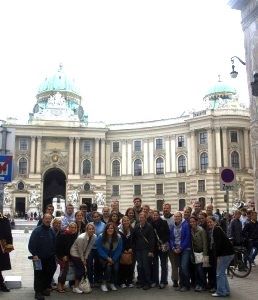Greetings from Vienna–and I don’t mean Illinois. We’re finally in “central” as opposed to Eastern Europe, and as far west as we’re going to be.
And Vienna certainly provides contrasts to the medieval or Russian cities we’ve visited–ironically, it was the capital of the Austro-Hungarian Empire, which at one time or another included all the non-Baltic, non-Russian states that we’re visiting. It’s more 19th century, and seemingly more Western. Two quick items that indicate the latter: the metro cost 2.20 Euros, roughly 2.75$–most previous cities were less than $1. Second, the drivers in Eastern Europe actually stopped for pedestrians. Here, you’re as safe crossing the street as in Chicago.
Our guide made an interesting observation re: Vienna. Our medieval cities that we’ve visited peaked in the medieval times; as I mentioned, Prague was the capital of the Holy Roman Empire only once in its history, and until 1918 had not been the capital of a country since the 14th century. Hence, Prague kept its medieval old city.
By contrast, Vienna was the capital of a thriving 19th century empire of 55 million people, and as such, attempted to keep the pretensions of imperial might. Though it had played a critical role in saving Europe from the Turkish invaders in the 1520s and 1683 (the latter with the aid of the timely arrival of Jon III Sobieski’s Polish Army), Vienna flourished after the Congress of Vienna in 1815 that basically set Europe’s boundaries for the next century.
Emperor Franz Joseph in particular, who ruled from the 1840s until his death in 1916 (just two years before the end of the Hapsburg dynasty and the end of Austria-Hungary) rebuilt much of the city in the 18th century style, 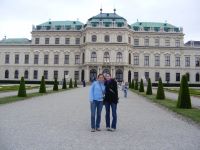 tearing down the walls, adding to the Hofburg (the winter palace of the imperial family, which started in the 13th century), and left a city full of pompous, pretentious, and ponderous monuments designed to dazzle–which they do today even as the capital of a country of only 8 million Austrians.
tearing down the walls, adding to the Hofburg (the winter palace of the imperial family, which started in the 13th century), and left a city full of pompous, pretentious, and ponderous monuments designed to dazzle–which they do today even as the capital of a country of only 8 million Austrians.
We had basically a three-hour tour of the 19th century, which took us past most of the features: the Stephendom, an enormous Cathedral that started 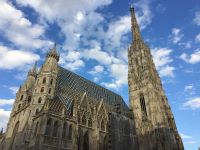 to be built in the Gothic period and finally more or less finished in the 19th century. Its approach is via streets that resemble Michigan Avenue and have many of the same stores. The Ring which replaced the defense walls circles the major museums and other government buildings, including the library, the Lippanzer horse stables, the outstanding military museums and the art museum.
to be built in the Gothic period and finally more or less finished in the 19th century. Its approach is via streets that resemble Michigan Avenue and have many of the same stores. The Ring which replaced the defense walls circles the major museums and other government buildings, including the library, the Lippanzer horse stables, the outstanding military museums and the art museum.
It is an imperial city. Tourists agree. They’ve made it one of the most visited cities in Europe; our guide mentioned tourism as one of the major businesses of Austria. She pointed out that with Austria so close to the Soviet borders in the Cold War there was little foreign investment because of the fear that the Cold War might turn hot. The country was run by joint occupation of the war-time allies until a 1955 treaty that pulled out everyone’s troops and neutralized Austria; one provision was that the Allied statues had to remain. There’s only one–to the Russian armies that liberated the city. The conquering Soviet general demanded the construction of a statue to his soldiers, and since there were no other building materials, he reputedly confiscated the bronze busts of Hitler and Goering, and melted them down. We also drove past some interesting early 20th century architecture, including art deco, art nouveau, and secessionist. The latter built a building that our guide in a malaprop called garbage, when she meant a dome that looks like a cabbage, but, she might have been right anyway.
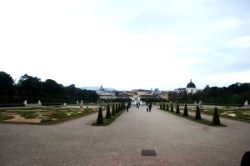
My favorite new place was one I really wanted to visit last summer, but ran out of time–Belvidere, the summer palace of Prince Eugene of Savoy, one of the few successful Austrian generals (Austria tended to survive and expand by marrying its excess sons and daughters into other royal families, rather than winning wars). Prince Eugene, who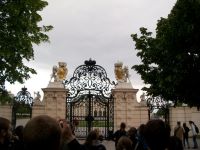 commanded Austrian Armies against Napoleon, was reputed to have been short, ugly, and hunchback, which led to France and Germany rejecting his application for an officer’s commission, but desperate Austria welcomed him and paid him handsomely; he was the richest man in the Empire. His summer home reflects it–as it has the best view of the city of Vienna from sumptuous gardens. Today an art museum, it is supposed to have one of the finest collections of Gustav Klimt.
commanded Austrian Armies against Napoleon, was reputed to have been short, ugly, and hunchback, which led to France and Germany rejecting his application for an officer’s commission, but desperate Austria welcomed him and paid him handsomely; he was the richest man in the Empire. His summer home reflects it–as it has the best view of the city of Vienna from sumptuous gardens. Today an art museum, it is supposed to have one of the finest collections of Gustav Klimt.
And finally, she noted some of the musical sights that must have made 18th and 19th century Vienna one of the most exciting places to be–the home of Mahler (my personal favorite), Mozart (have you ever heard anything he wrote that you did not like?), Bruckner, etc. The old Opera House was sold out tonight, or some of us might have heard La Traviata.
Instead we savored walking streets of Vienna, enjoying the cafes and pastries, and getting back reasonably early, which is very Viennese.
We board a hydrofoil for the trip to Budapest tomorrow at 8 a.m. In the meantime, I’m going to snack on my Sacher Tort (named for the hotel across from the Opera House where it was invented) and take a rest.
Goodnight everyone.
